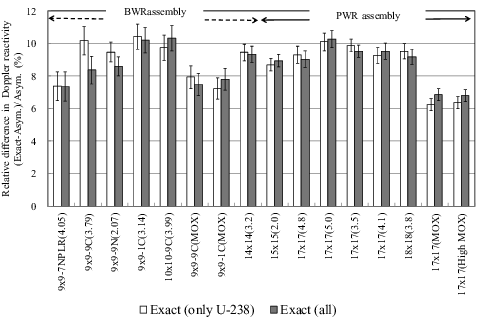ABSTRACT
Using the continuous-energy Monte Carlo code MVP-2 adopting a resonance elastic scattering model considering the thermal motion of a target nucleus (the exact model) for major heavy nuclides, analysis of fuel temperature effects on reactivity of mockup UO2 and MOX fuel assemblies for light water reactors was performed, and the results were compared with those of the conventional asymptotic model. A base condition was a hot operating condition with an in-channel void fraction of 40% and fuel temperature of 520 ℃ for the BWR fuel assemblies and a hot zero-power condition with fuel temperature of 284 ℃ for the PWR fuel assemblies. The fuel temperature of a high-temperature condition was 1500 ℃ for both types of assemblies. The calculated results showed that the exact model made the neutron multiplication factors at the high-temperature condition lower by −220 to −440 pcm (10−5 Δk) and the Doppler reactivity between the base- and high-temperature conditions more negative by 7% to 10% compared with those obtained by the asymptotic model. The energy-dependent reaction rates of capture and ν-fission were also analyzed to study the detail mechanism in the effect of the exact model on the assembly reactivity.
1. Introduction
Doppler reactivity is one of the important feedback effects in the safety analysis of nuclear power plants especially in transient and accident events where the reactivity of a reactor core exceeds a prompt critical state and the power steeply surges. This feedback reactivity is closely related to the increase of neutron capture reactions of 238U in the epithermal neutron energy region as nuclear fuel is heated. The conventional treatment of resonance capture reactions of heavy nuclides in the epithermal neutron energy region has adopted the asymptotic model which is based on rest nuclei and constant elastic scattering cross sections by neglecting the thermal motion of nuclei and the resonance elastic scattering. Since Ouisloumen and Sanchez [Citation1] indicated that the resonance elastic scattering of heavy nuclides could have a considerable effect on the average energies of scattered neutrons, a lot of studies have been carried out to improve the analysis method by taking into account these effects on neutron multiplication factors and Doppler reactivity for thermal reactor fuels [Citation2–12]. shows the elastic scattering and capture cross sections in 1–103 eV for 238U [Citation13] which was studied in most references since these cross sections are most important in quantifying the effect of the resonance elastic scattering to the neutron multiplication factors and Doppler reactivity in thermal reactor fuels. On the other hand, questions had been arisen if the resonance elastic scattering of other heavy nuclides such as 235U for UO2 fuels, and 239Pu, 240Pu, and 241Pu for MOX fuels does not have significant influence on neutron multiplication factors, and if the changes in neutron flux distributions caused by the exact treatment of resonance elastic scattering of 238U do not affect fission and capture reactions of the fissile nuclides. and show the elastic scattering, fission, and capture cross sections of 235U and 239Pu in 1–103 eV. In the figures, fission cross sections are also shown for those nuclides since, in addition to capture cross sections, fission reactions can be enhanced by the exact treatment of resonance elastic scattering to increase the reactivity of fuel. As the figures show, the resonance elastic cross sections of 235U and 239Pu are relatively smaller compared with the resonance elastic cross sections of 238U. The increases in fission reactions may be somehow cancelled by the increases in capture reactions. Therefore, 238U seems to be only major nuclide for the influence of resonance elastic cross sections; however, it is worth quantifying the effect on reactivity from other heavy nuclides other than 238U.
Figure 1. Neutron elastic scattering and capture cross sections of 238U in 1–103 eV [Citation13]. The figures attached to the major resonance peaks are neutron energies of the peaks.
![Figure 1. Neutron elastic scattering and capture cross sections of 238U in 1–103 eV [Citation13]. The figures attached to the major resonance peaks are neutron energies of the peaks.](/cms/asset/5db76801-41c4-476f-864f-af0a1f137d05/tnst_a_1136903_f0001_oc.jpg)
Figure 2. Neutron elastic scattering, fission, and capture cross sections of 235U in 1–103 eV [Citation13].
![Figure 2. Neutron elastic scattering, fission, and capture cross sections of 235U in 1–103 eV [Citation13].](/cms/asset/ced69a9a-e01f-4125-9ad7-94071041b3d0/tnst_a_1136903_f0002_oc.jpg)
Figure 3. Neutron elastic scattering, fission, and capture cross sections of 239Pu in 1–103 eV [Citation13].
![Figure 3. Neutron elastic scattering, fission, and capture cross sections of 239Pu in 1–103 eV [Citation13].](/cms/asset/cdba6bdb-2c2d-4c3f-8407-3dd001d55df0/tnst_a_1136903_f0003_oc.jpg)
The continuous-energy Monte Carlo code MVP-2 has been developed by the Japan Atomic Energy Agency (JAEA) [Citation14] and widely used as a reference code and also a design tool for nuclear installations. Mori and Nagaya [Citation9] have reported a study on the resonance elastic scattering models in the epithermal neutron energy region by installing the relevant models into MVP-2 by adopting the weight correction method [Citation5]. It indicated that an exact resonance elastic scattering model (hereafter, referred to as “the exact model”), which took into account the thermal motion and resonance elastic scattering of heavy nuclides such as 235U and 238U, gave more negative Doppler reactivity by 7%–11% than the asymptotic model.
The Japan Nuclear Energy Safety Organization (JNES) has entrusted JAEA with installing the exact model to the latest version of MVP-2 and also preparing the libraries of elastic scattering cross sections at 0 K, which are necessary to actuate the exact model, based on the latest evaluated nuclear data library JENDL-4.0 [Citation13] for 235U, 238U, 238Pu, 239Pu, 240Pu, 241Pu, 242Pu, and 241Am which are the major heavy nuclides to contribute to reactivity of UO2 and MOX fuel assemblies used in light water reactors (LWRs).
Using MVP-2 coupled with the exact model and the libraries of 0 K, the authors performed the analysis of temperature effect on reactivity of various mockup fuel assemblies for LWRs and compared with those obtained by the asymptotic model to quantify the contribution to the effect of the exact model from 238U and all the other heavy nuclides except 238U [Citation12]. The aim of this study is to extend the analysis result in the field of the energy-dependent reaction rates in order to interpret the effect of the exact model. The obtained results will be additional information to the database for the validation of MVP-2 which is used as a reference code. Section 2 describes the fuel assemblies and the analysis conditions, and Section 3 shows the analysis results of the effect of the exact model. Section 4 mentions conclusions.
2. LWR fuel assemblies and analysis conditions
2.1. Fuel assemblies
The mockup fuel assemblies analyzed in this study were seven BWR types and nine PWR types. Later alone in the text, “fuel assembly” will be described as “assembly.” Four assemblies among them are MOX assemblies and the others UO2 assemblies. The lattice types of the BWR assemblies are 9 × 9 and 10 × 10. Those of the PWR assemblies are 14 × 14, 15 × 15, 17 × 17, and 18 × 18. The assembly average enrichments of the BWR UO2 assemblies are 2.1–4.1 wt%. The enrichments of UO2 fuel rods of the PWR UO2 assemblies are 2.0–4.8 wt%. The assembly IDs and some of representing parameters are listed in . The Pu isotopic weight fractions of the MOX fuel rods are typical ones of LWR MOX fuels. The weight fractions of fissile Pu isotopes and 240Pu are 67–68 wt% and 23–27 wt%, respectively [Citation15]. Some of the assembly specifications and the Pu isotopic weight fractions were taken from the published information and the others were estimated for this study; therefore, the specifications here are somehow different from those of actual designs. In , the values of a surface-to-mass ratio S/M (cm2/g) ( = 4/(Dρ) are also shown, where D is the fuel pellet diameter (cm) and ρ is the pellet density (g/cm3)) of UO2 or MOX fuel pellets.
Table 1. List of analyzed mockup assemblies [Citation12].
2.2. Analysis conditions
The base condition of the BWR assemblies was a hot operating condition with an in-channel void fraction of 40%. The temperatures of fuel pellets, fuel claddings, and moderator were set to be 520 ℃ (793 K), 286 ℃ (559 K), and 286 ℃ (559 K), respectively. The temperature distributions in the materials were neglected. The base condition of the PWR assemblies was a hot zero-power (HZP) condition. The temperatures of fuel pellets, fuel claddings, and moderator were set to be 284 ℃ (557 K). The content of boron in the moderator of the PWR assemblies was 1000 ppm. The fuel was at an unburned condition. From the base condition, only the fuel pellet temperature was changed to 1500 ℃ (1773 K). The base condition of the PWR assemblies was selected to study the base condition of the fuel pellet temperature lower than that of the BWR assemblies. It was also aimed at making larger the difference in the fuel temperature between the base- and high-fuel-temperature conditions to enhance the effect of the exact model.
Adopting a two-dimensional (2D) geometry model and atomic number densities of materials composing the assembly, sampling calculations of 2100 batches with 40,000 neutron histories per batch were performed by using MVP-2, and the initial 100 batches were skipped from the statistical process, which were selected to obtain the statistical uncertainties of infinite neutron multiplication factors (kinf's) less than 10 pcm (1σ) (1 pcm = 0.00001 △k). For variance reduction, a weight-window option was applied to the calculations with the exact model.
3. Analysis results on effect of exact model for LWR fuel assemblies
3.1. Infinite multiplication factors and Doppler reactivity
The calculated results of kinf's obtained by using the asymptotic and the exact models are shown in for the base-temperature conditions and for the high-temperature condition, where the results of the exact model are those obtained by applying the model to all nuclides for which the 0-K libraries were available. The tables also show differences in kinf's between the asymptotic and the exact models, and also the statistical uncertainties in 1σ for the results. The results of the asymptotic model are shown in the column shown as “Asymptotic,” those of the exact model in that shown as “Exact.” The differences between the results of the exact and asymptotic models are in the column shown as “Diff. (Exact-Asym.).”) The uncertainties are in the columns shown as “Unc” and “Unc. of Diff.” The results of the MOX assemblies are shown in the shaded rows.
Table 2. kinf's of the assemblies calculated by using MVP-2 coupled with the asymptotic and exact models for the base conditions [Citation12].
Table 3. kinf's of the assemblies calculated by using MVP-2 coupled with the asymptotic and exact models for the high-temperature condition [Citation12].
In order to study the detail effect of the exact model, energy-dependent reaction rates of the heavy nuclides in the fuel pellets were calculated at the fuel temperature of 1500 ℃ for the PWR 17 × 17 (4.8) UO2 and PWR 17 × 17 (MOX) assemblies as representing assemblies by using MVP-2 under the same conditions mentioned above. The neutron energy groups were 107 from 10−5 to 10+7 eV. The reaction rates were normalized in the way that a total ν-fission (a number of fission neutrons multiplied by a fission reaction rate) was 1.0 and the groupwise reaction rate was divided by the lethargy width of the group. The differences in groupwise reaction rates between the exact and asymptotic models are shown in and
Figure 4. Differences in groupwise reaction rates between the exact and asymptotic model calculations for the PWR 17 × 17 (4.8) UO2 assembly at the fuel temperature of 1500 ℃.
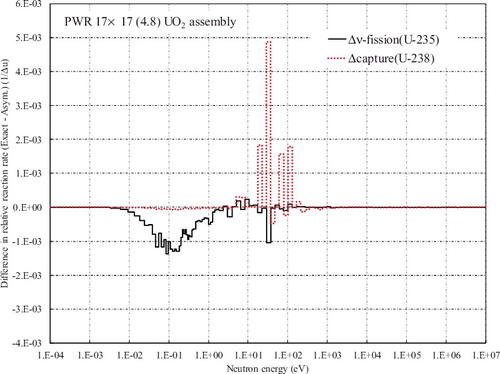
Figure 5. Differences in groupwise reaction rates between the exact and asymptotic model calculations for the PWR 17 × 17 (MOX) assembly at the fuel temperature of 1500 ℃.
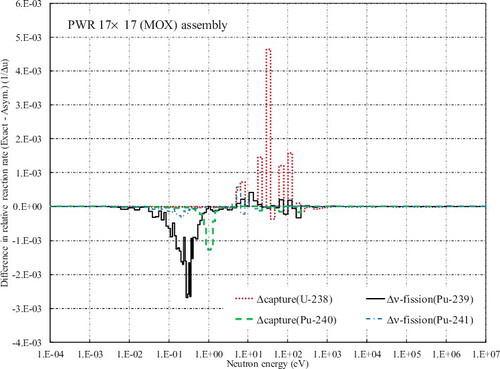
As shown in , major differences in the reaction rates are seen in the capture of 238U and the ν-fission of 235U for the UO2 assembly. They are shown as “Δ capture (U-238)” and “Δ ν-fission (U-235),” respectively, in the figure. The energy groups showing prominent increases in capture reaction rates respond to resonance peak energies, 6.7, 20.9, 36.7, 66.0, and 102.6 + 119.3 eV. The condition of the large effect of the resonance elastic scattering on the assembly reactivity is that the relevant resonances have larger resonance widths of both elastic scattering and capture reactions as discussed by Mori and Nagaya [Citation7]. For instance, the resonance peak of 36.7 eV shows the largest effect; that of 6.7 eV a smaller effect since the latter has a smaller elastic scattering width. The effect is not significant for resonances in the neutron energy larger than 130 eV, since they do not satisfy the condition and the up-scattering effect is not significant. These observations are partly different from the Doppler effect itself (the effect of increased temperature of the pellet) since the increase in neutron capture rates distributes in a wider neutron energy region up to around 104 and they are correlated solely to the capture widths of the resonance peaks. shows the differences in the groupwise reaction rates between 1500 and 284 ℃ for the PWR 17 × 17 (4.8) UO2 assembly. The reaction rates at both the temperature conditions were calculated in the asymptotic model. It should be reminded that the differences in the reaction rates are larger by one order than those between the exact and asymptotic models.
Figure 6. Differences in groupwise reaction rates of the calculations with the asymptotic model between 1500 and 284 ℃ of the pellet temperatures for the PWR 17 × 17 (4.8) UO2 assembly.

Looking at the differences in ν-fission reactions of 235U in , there is a prominent dip at the bottom of the prominent peak of 238U capture. This may be caused by significant decrease in neutron flux in the energy group, where the fission reaction rates of 235U largely decrease. The broad dip with a peak of around 0.1 eV corresponds to a thermal absorption peak. The differences in the shapes of differences in ν-fission reactions less than 1 eV in and would be attributed to that the differences in come from the change in the thermal neutron energy spectrum caused by the enhanced up-scattering of thermal neutrons due to the pellet temperature increase.
As shown in , major differences in the reaction rates are seen in the neutron capture of 238U and 240Pu, and the ν-fission of 239Pu and 241Pu for the PWR 17 × 17 (MOX) assembly. The increase in capture reaction rates of 238U is similar to that for the PWR 17 × 17 (4.8) UO2 assembly. A broad decrease around 0.3 eV in ν-fission reaction rates of 239Pu corresponds to a broad fission peak around 0.3 eV. It is due to that increase in resonance capture reaction rates of 238U in the energy 1–130 eV cause decreases in lower energy neutrons less than 10 eV. This also decreases the neutron capture reaction rates of 240Pu at a resonance capture of 1 eV as shown in the figure. The PWR 17 × 17 (MOX) assembly has a harder energy spectrum so that the thermal peak is almost disappear in the neutron energy spectrum. Small increases in the energy groups around 10 eV may be caused by fission reactions of 239Pu and 241Pu enhanced by elastic resonance scattering reactions of these nuclides. It should be reminded that the effects on the neutron capture reactions of 240Pu and fission reactions of 239Pu and 241Pu increase the reactivity of the assemblies and partly compensate the effects of the neutron capture reactions of 238U. In order to characterize the mechanism of the exact model in the MOX fuels, shows the differences in the groupwise reaction rates caused by the pellet temperature differences between 1500 and 284 ℃ for the PWR 17 × 17 (MOX) assembly. It is understood that the effect of the exact model at 1500 ℃ is smaller by about one order than that caused by the temperature difference between 1500 and 284 ℃. The capture rates at around 1 eV of 240Pu increase with the rise of the pellet temperature, which is different from that in applying the exact model.
Figure 7. Differences in groupwise reaction rates of the calculations with the asymptotic model between 1500 and 284 ℃ of the pellet temperatures for the PWR 17 × 17 (MOX) assembly.
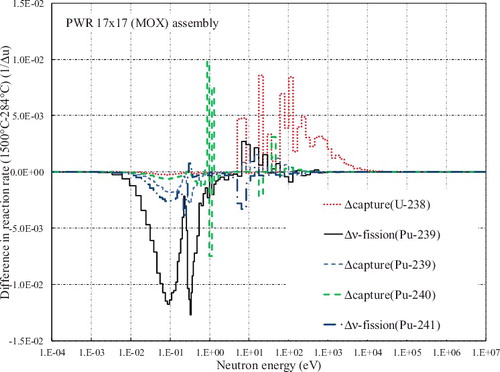
illustrates the differences in kinf's between the asymptotic and exact models shown in and . Comparing the negative effect in kinf's of the exact model for the base temperature and the high temperature (1500 ℃) shows that the effect of the exact model constantly increases with the pellet temperature. The differences in kinf's between the asymptotic and exact models for the base condition are slightly larger for the BWR UO2 assemblies than those for the PWR UO2 assemblies. It is due to the difference in the fuel pellet temperatures at the base condition (520 ℃ for the BWR assemblies and 284 ℃ for the PWR assemblies). For both BWR and PWR assemblies, the negative effect in kinf's is relatively smaller for the MOX assemblies than that for UO2 assemblies. This is attributed to the fact that the atomic densities of the most influential nuclide of the exact model, 238U, are relatively smaller for the MOX assemblies than those of the UO2 assemblies, which is prominent in the PWR MOX assemblies, and to the compensation effect by the decrease in neutron capture rates of 240Pu at 1 eV. As mentioned above, the mechanism of the effect of the resonance elastic scattering is mainly related to strong resonances of 238U in a narrow neutron energy range and the secondary effect on the thermal fission rates of fissile nuclides such as 235U and 239Pu, and the resonance capture rate of 240Pu; therefore, the degree of the effect seems to depend on the neutron energy spectra of the fuel assemblies.
Figure 8. Differences in kinf's between the asymptotic and exact models for the base- and high-temperature conditions.
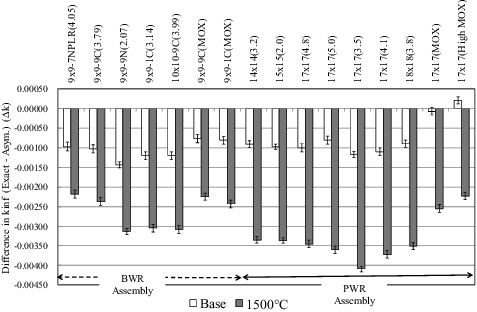
and show the Doppler reactivity in a unit: △k/kk' caused by increasing the pellet temperature to 1500 ℃ from the base temperature. They are also attached by its uncertainty (1σ). The table shows the differences in the Doppler reactivity between the two models. The differences in the Doppler reactivity between the BWR and PWR assemblies are due to the differences in increased pellet temperature. They are 980 ℃ for the BWR assemblies and 1216 ℃ for the PWR assemblies. The relative differences in the Doppler reactivity between the two models, which are in the column shown as “Relative Diff. ((Exact-Asym.)/Asym.)”), are also shown in . The Doppler reactivity of the two models for the UO2 assemblies is similar to that of the MOX assemblies for both BWR and PWR assemblies as seen in . The effects of the exact model on the Doppler reactivity range from 7% to 10% for both BWR and PWR assemblies as seen in . They are similar to those reported in the previous studies [Citation5,Citation7,Citation8,Citation11].
Table 4. Doppler reactivity (base to 1500 ℃) of the assemblies calculated by using MVP-2 coupled with the asymptotic and exact models [Citation12].
Figure 9. Doppler reactivity (base to 1500 ℃) with the asymptotic and exact models [Citation12]. The base temperatures are 520 ℃ for the BWR assemblies and 284 ℃ for the PWR assemblies.
![Figure 9. Doppler reactivity (base to 1500 ℃) with the asymptotic and exact models [Citation12]. The base temperatures are 520 ℃ for the BWR assemblies and 284 ℃ for the PWR assemblies.](/cms/asset/2fc81d70-7e50-4292-bd2b-170655322bab/tnst_a_1136903_f0009_b.gif)
Figure 10. Relative differences in Doppler reactivity (base to 1500 ℃) between the calculations of the asymptotic and exact models [Citation12].
![Figure 10. Relative differences in Doppler reactivity (base to 1500 ℃) between the calculations of the asymptotic and exact models [Citation12].](/cms/asset/d936715b-0a85-45c1-939b-b022d94c775c/tnst_a_1136903_f0010_b.gif)
The relative differences for the BWR assemblies are 7%–10% for the UO2 assemblies and 7%–8% for the MOX assemblies; those for the PWR assemblies 9%–10% for the UO2 assemblies and about 7% for the MOX assemblies. Even though the Doppler reactivity is similar for both UO2 and MOX assemblies as seen in , the effects of the exact model on the MOX assemblies are a few percent less than those of the UO2 assemblies. This trend was also reported by Ono et al. [Citation8]. Main reasons would be that the number densities of 238U in the MOX assemblies are relatively smaller than those in UO2 assemblies as mentioned by Ono et al. [Citation8]. In addition, it would be also attributed to the fact that the decrease in capture reactions of 240Pu as the secondary effect of the exact model compensates the negative reactivity of the exact model from 238U as mentioned about the influences on the groupwise reaction rates from the exact model. Among the UO2 assemblies, there are differences in the effect of the exact model on the Doppler reactivity. Further study is necessary to discuss the causes of differences in the effect of the exact model seen in the different UO2 assembly types.
3.2. Effect of 238U and other nuclides
The previous studies [Citation3,Citation5,Citation6] and this study indicate that the effect of the exact model came from the elastic-scattering-dominant resonances of 238U. Even though 238U is the dominant nuclide to calculate the Doppler reactivity for both UO2 and MOX assemblies, it would be useful to know if applying the exact model only to 238U is enough to calculate the Doppler reactivity for LWR fuel assemblies. For this purpose, the analysis was performed by applying the exact model only to 238U and also only to all the other nuclides except 238U.
3.2.1. 238U
The calculated Doppler reactivity for applying the exact model only to 238U was compared with those of the asymptotic model. graphically shows the comparison in the effects of the exact model on the Doppler reactivity by applying the exact model to only 238U and to all the nuclides. Statistically significant difference in the effect of the exact model is hard to be recognized by applying the exact model only to 238U and all nuclides. It indicates that applying the exact model to the heavy nuclides other than 238U does not reduce the uncertainty in the calculations of Doppler reactivity of LWR assemblies.
3.2.2. All nuclides except 238U
In order to confirm the effect of the nuclides except 238U, the calculations were performed by applying the exact model to all nuclides except 238U for representing UO2 and MOX assemblies of BWR and PWR. For the base conditions, the effects on kinf's are negative for the UO2 assemblies and positive for the MOX assemblies as shown in . For the high-temperature condition, they are positive for both UO2 and MOX assemblies. As a result, the exact model makes the Doppler reactivity less negative by a few percent as shown in . This behavior is opposite to that in applying the exact model only to 238U, where the effect of the exact model on kinf's is negative for the high-temperature condition. In order to understand these observations in details, the groupwise reaction rates of the exact model which was applied to all the nuclides except 238U were calculated for the PWR 17 × 17 (4.8) UO2 and PWR 17 × 17 (MOX) assemblies at the fuel temperature of 1500 ℃, and the differences in the groupwise reaction rates between the exact and asymptotic model calculations were obtained. They are shown in for the PWR 17 × 17 (4.8) UO2 assembly and for PWR 17 × 17 (MOX) assembly. As seen in and , reaction rates of the ν-fission of 235U, 239Pu, and 241Pu are slightly increased in the epithermal energy region. In addition to this trend, the decrease of neutron capture rates of 238U is observed in both figures. This may be attributed to the fact that the exact model applied to resonance elastic scattering of nuclides other than 238U modifies the neutron energy spectra around the epithermal energy region, and it causes the decrease in the resonance neutron capture rates of 238U. As seen in , the difference in reaction rates in the energy region less than 1 eV shows fine structures which are slightly different from those seen in
Figure 12. Differences in kinf's between the asymptotic and exact models (all nuclides except 238U) for the base- and high-temperature conditions.

Figure 13. Comparison of the effects on Doppler reactivity of the exact model between applying to all nuclides except 238U and that to all nuclides.

Figure 14. Differences in groupwise reaction rates between the exact and asymptotic model calculations for the PWR 17 × 17 (4.8) UO2 assembly at the fuel temperature of 1500 ℃, where the exact model was applied to all nuclides except 238U.
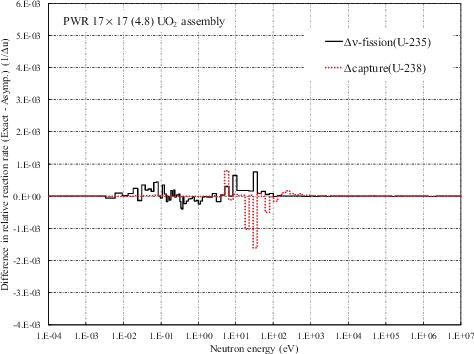
Figure 15. Differences in groupwise reaction rates between the exact and asymptotic model calculations for the PWR 17 × 17 (MOX) assembly at the fuel temperature of 1500 ℃, where the exact model was applied to all nuclides except 238U.
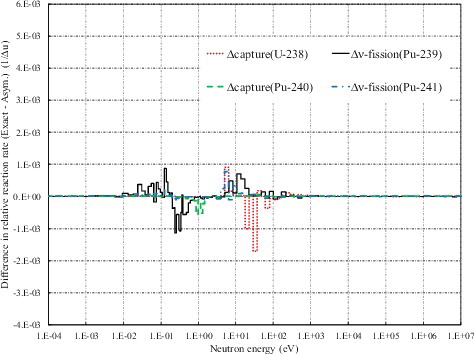
The observation here does not accord with the observations in the case of applying the exact model only to 238U. However, there would exist a statistical problem since the effect of the exact model is very close by applying it only to 238U and to all nuclides. The effect of the exact model in applying it to all nuclides may not be simple summation of each nuclide since there would be interaction between each nuclide.
4. Conclusions
Appling the exact model of resonance elastic scattering to 235U, 238U, 238Pu, 239Pu, 240Pu, 241Pu, 242Pu, and 241Am, the analysis of the kinf's and the Doppler reactivity were performed by using MVP-2 for the mockup UO2 and MOX assemblies for LWRs, and the results were compared with those of the asymptotic model. For this purpose, the base condition of the assemblies was set at the hot operating condition with the in-channel void fraction of 40% and the fuel pellet temperature of 520 ℃ for BWR assemblies and the hot zero-power condition with the fuel pellet temperature of 284 ℃ for PWR assemblies, and the fuel pellet temperature was increased to 1500 ℃ for the high-temperature condition. The calculated results showed that the differences in kinf's between the exact and asymptotic models were −220 to −410 pcm at the 1500 ℃ condition, and the exact model made the Doppler reactivity between the base and the 1500 ℃ conditions more negative by 7%–10%. The reactivity of the assemblies and Doppler reactivity obtained by applying the exact model only to 238U were statistically same as those obtained by applying it to all the heavy nuclides. On the other hand, applying the exact model to all the heavy isotopes except 238U made the Doppler reactivity less negative by a few percent compared with that obtained by applying the asymptotic model.
The comparison of the energy-dependent reaction rates of capture and ν-fission for the major heavy nuclides between the exact and asymptotic models was shown to discuss the detail mechanism in the influence of the exact model on the reactivity for the representing mockup UO2 and MOX assemblies. The obtained results will be additional information to the database for the validation of MVP-2 which is used as a reference code.
Acknowledgments
The authors would like to thank Dr Y. Nagaya of the Japan Atomic Energy Agency for providing the MVP-2 code and library, and supporting the use of the code for implementing this study.
Disclosure statement
No potential conflict of interest was reported by the authors.
REFERENCES
- Ouisloumen M, Sanchez R. A model for neutron scattering off heavy isotopes that accounts for thermal agitation effects. Nucl Sci Eng. 1991;107:189–200.
- Rothenstein W. Proof of the formula for the ideal gas scattering kernel for nuclides with strongly energy dependent scattering cross sections. Ann Nucl Energy. 2004;31:9–23.
- Dagan R, Broeders CHM. On the effect of resonance dependent scattering-kernel on fuel cycle and inventory. Proceeding of PHYSOR-2006; 2006 Sep 10–14; Vancouver; 2006.
- Kolesov VV, Ukraintsev VF. Temperature effects and resonance elastic cross section influence on secondary energy distributions of scattered neutrons in the resolved resonance region. Proceeding of PHYSOR-2006; 2006 Sep 10–14; Vancouver; 2006.
- Lee D, Smith K, Rhodes J. The impact of 238U resonance elastic scattering approximations on thermal reactor Doppler reactivity. Proceeding of PHYSOR-2008; 2008 Sep 14–19; Interlaken; 2008.
- Becker B, Dagan R, Broeders CHM, et al. Improvement of the resonance scattering treatment in MCNP in view of HTR calculations. Ann Nucl Energy. 2009;36:281–285.
- Mori T, Nagaya Y. Comparison of resonance elastic scattering models newly implemented in MVP continuous-energy Monte Carlo code. J Nucl Sci Technol. 2009 Aug;46:793–798.
- Ono M, Wada K, Kitada T. Simplified treatment of exact resonance elastic scattering model in deterministic slowing down equation. Proceeding of PHYSOR 2012; 2012 Apr 15–20; Knoxville (TN); 2012.
- Zoia A, Brun E, Jouanne C, et al. Doppler broadening of neutron elastic scattering kernel in TRIPOLI-4(R). Ann Nucl Energy. 2013;54:218–226.
- Mao L, Zmijarevic I. The up-scattering treatment in the fine-structure self-shielding method in APOLLO03(R). Proceeding of PHYSOR 2014; 2014 Sep 28–Oct 3; Kyoto; 2014.
- Ouisloumen M, Ougouag AM, Ghrayeb SZ. Anisotropic elastic resonance scattering model for the neutron transport equation. Nucl Sci Eng. 2015;179:59–84.
- Yamamoto T, Sakai T. Analysis of temperature effects on reactivity of light water reactor fuel assemblies by using MVP-2 adopting an exact resonance elastic scattering model. Proceeding of ANS MC2015; 2015 Apr 19–23; Nashville (TN); 2015.
- Shibata K, Iwamoto O, Nakagawa T, et al. JENDL-4.0: a new library for nuclear science and engineering. J Nucl Sci Technol. 2011;48:1–30.
- Nagaya Y, Okumura K, Mori T, et al. MVP/GMVP II: general purpose Monte Carlo codes for neutron and photon transport calculations based on continuous energy and multigroup methods. Tokai-mura: Japan Atomic Energy Research Institute; 2005. (JAERI-1348).
- Burnup dependency of nuclear characteristics of high burnup MOX and UO fuels for light water reactors. Tokyo: Japan Nuclear Energy Safety Organization; 2007. (JNES-SS-0709). Japanese.

